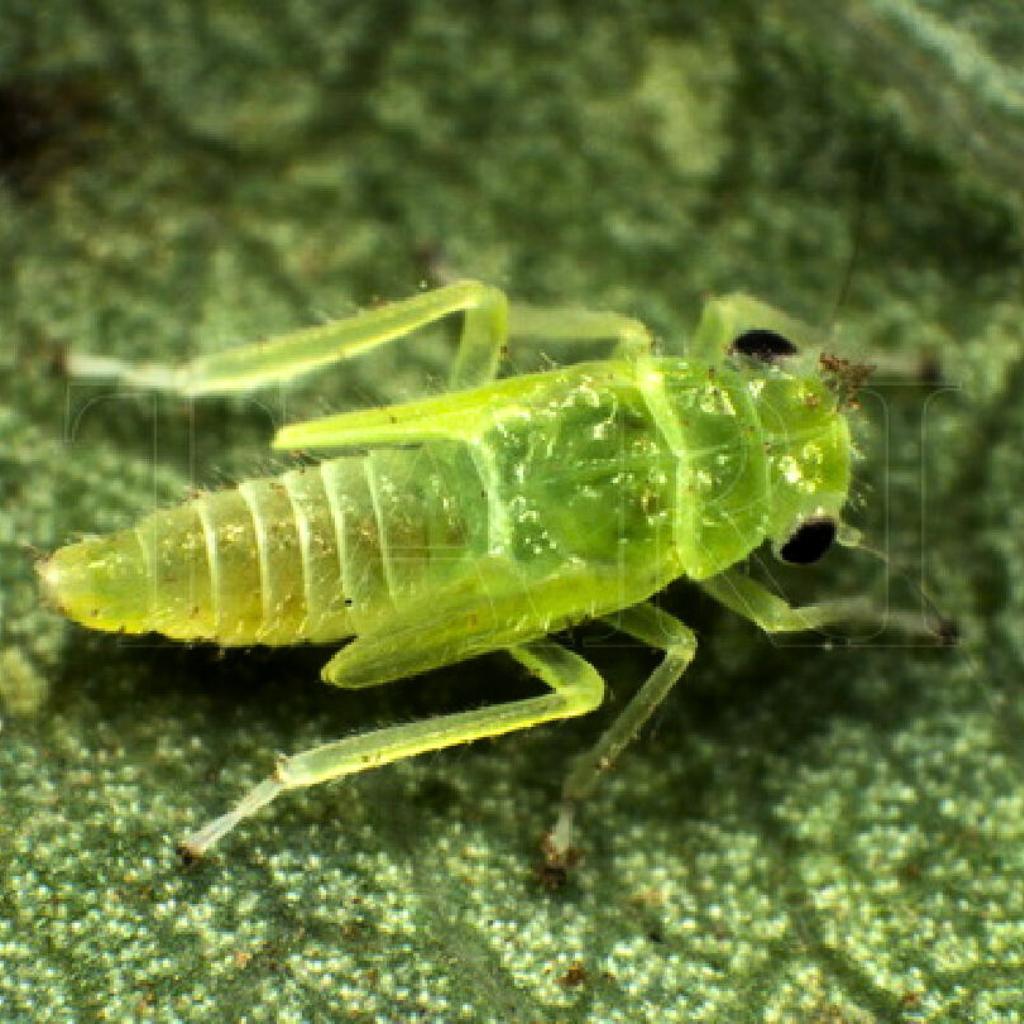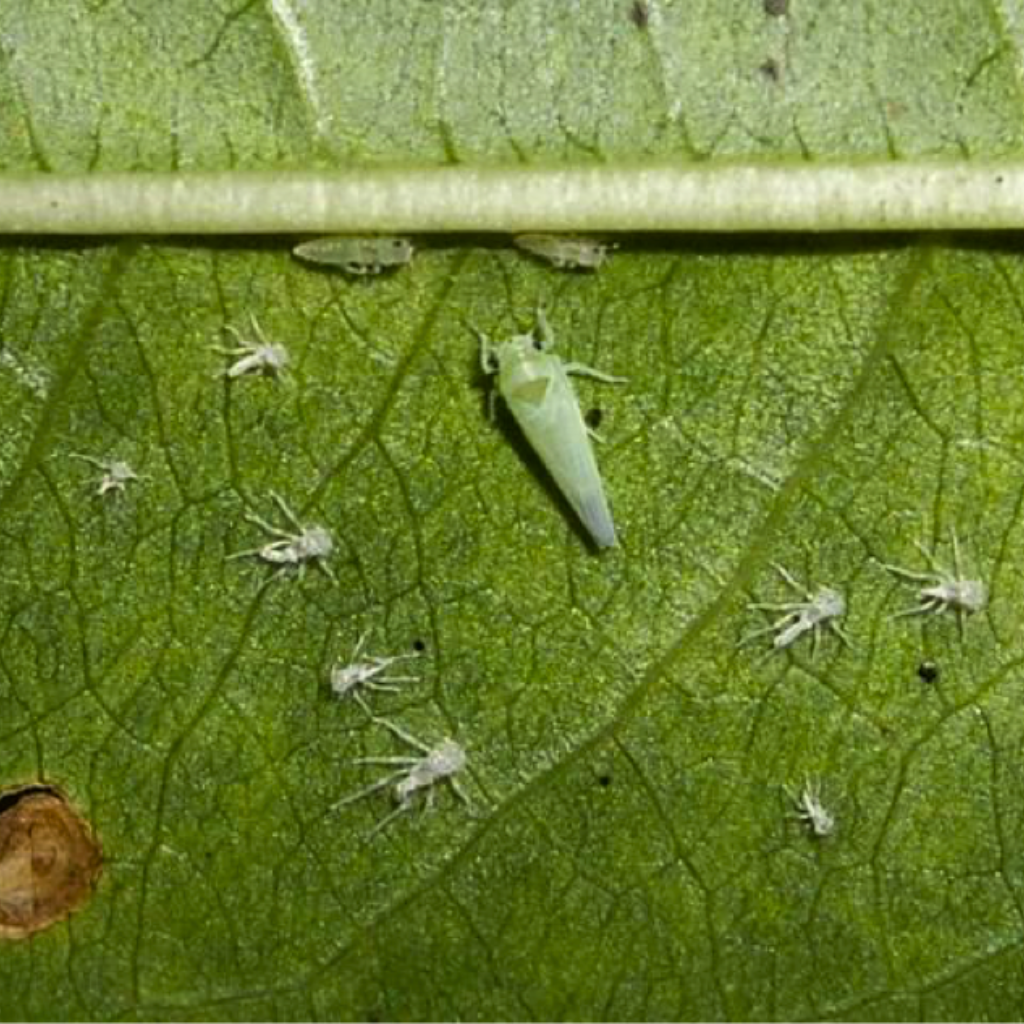



叶蝉 Leafhoppers
| 分类 | 中文 | English |
|---|---|---|
| 成虫 Adult | 体长约2.0–4.5 mm,体形狭长呈楔形,常为绿色、黄绿色或褐色,翅呈瓦状平伏,善跳跃并能短距离飞行。 | Adults 2.0–4.5 mm long, wedge-shaped and slender, often green/yellow-green or brown; wings held roof-like, good jumpers and capable of short flights. |
| 卵 Eggs | 卵呈狭长椭圆或微弧形,通常产入叶片或茎的表皮裂缝或叶脉组织中,不易被发现。 | Eggs are elongate-oval or slightly curved, usually inserted into leaf or stem tissue (veins/epidermis) and are hard to detect. |
| 若虫 Nymphs | 若虫无翅,体色偏浅(乳白、黄绿等),活动敏捷,经过5个龄期发育,前期多在叶背聚集进食。 | Nymphs are wingless, pale (whitish to yellow-green), active, develop through five instars and commonly feed on leaf undersides in early stages. |
| 蛹 Pupae | 不适用(叶蝉为不完全变态,生活史为卵→若虫→成虫,无蛹期)。 | Not applicable — leafhoppers are hemimetabolous (egg → nymph → adult), they do not have a pupal stage. |
生长繁殖 / Growth & Reproduction
| 中文 | English |
|---|---|
| 叶蝉繁殖快,卵产入植物组织,孵化数天后出若虫。若虫经5龄逐渐发育为成虫;发育速率随温度加快,在适温下(地域与种类差异存在)一代可在约2–4周内完成。温暖或温室条件下可年发生多代。 | Leafhoppers reproduce rapidly. Females lay eggs into plant tissue; eggs hatch in a few days into nymphs. Nymphs pass through five instars to become adults; development accelerates with temperature and a generation may complete in roughly 2–4 weeks depending on species and conditions. Multiple generations occur per year in warm or protected environments. |
种群消长 / Population Dynamics
| 中文 | English |
|---|---|
| 种群随季节与寄主生长波动:春末至夏季温暖時期或生长旺季易增殖并发生爆发;干旱和温暖条件常利于增殖;强降雨、高湿或极端低温可抑制密度。局部连作或附近有大量替代寄主也会导致迁入与数量上升。 | Populations fluctuate with season and host growth: they often increase from late spring into summer or during host flushes. Warm, dry conditions favor build-up; heavy rain, high humidity or cold suppress populations. Continuous host crops or nearby alternate hosts can lead to immigration and local outbreaks. |
生活习性 / Habits
| 中文 | English |
|---|---|
| 叶蝉常在叶背或嫩梢刺吸取汁,取食造成叶面点状褪色、叶缘黄化或“hopper-burn”(叶缘或叶尖三角形黄褐化、卷曲、坏死)等症状;其唾液可引起植物生理性损伤。若虫和成虫均具高活动性,受扰会迅速跳跃或飞走。部分叶蝉也是病害(包括某些病毒/菌害/类病原)或病原体的传播者。 | Leafhoppers feed on undersides of leaves or young shoots; feeding causes stippling, marginal yellowing or characteristic “hopper-burn” (triangular yellowing/browning at leaf tips, curling and necrosis) due to toxic saliva. Nymphs and adults are highly mobile and jump or fly when disturbed. Some leafhoppers vector plant pathogens (viruses, phytoplasmas, etc.). |
生长繁殖 / Growth & Reproduction
| 中文 | English |
|---|---|
| 叶蝉繁殖快,卵产入植物组织,孵化数天后出若虫。若虫经5龄逐渐发育为成虫;发育速率随温度加快,在适温下(地域与种类差异存在)一代可在约2–4周内完成。温暖或温室条件下可年发生多代。 | Leafhoppers reproduce rapidly. Females lay eggs into plant tissue; eggs hatch in a few days into nymphs. Nymphs pass through five instars to become adults; development accelerates with temperature and a generation may complete in roughly 2–4 weeks depending on species and conditions. Multiple generations occur per year in warm or protected environments. |
种群消长 / Population Dynamics
| 中文 | English |
|---|---|
| 种群随季节与寄主生长波动:春末至夏季温暖時期或生长旺季易增殖并发生爆发;干旱和温暖条件常利于增殖;强降雨、高湿或极端低温可抑制密度。局部连作或附近有大量替代寄主也会导致迁入与数量上升。 | Populations fluctuate with season and host growth: they often increase from late spring into summer or during host flushes. Warm, dry conditions favor build-up; heavy rain, high humidity or cold suppress populations. Continuous host crops or nearby alternate hosts can lead to immigration and local outbreaks. |
